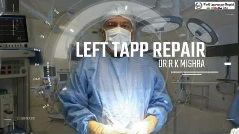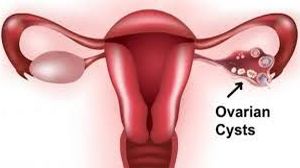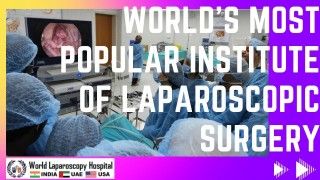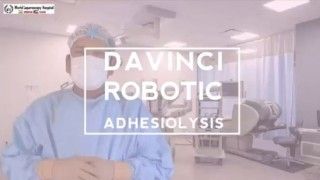Laparoscopic Assisted Orchiopexy for Undescended Testes: Dr. R K Mishra's Demonstration
Add to
Share
1,993 views
Report
2 years ago
Description
Advancing Pediatric Surgery: Dr. R K Mishra Demonstrates Laparoscopic-Assisted Orchiopexy for Undescended Testes Pediatric surgery has witnessed significant advancements in recent years, particularly in the treatment of undescended testes. One groundbreaking technique that has gained recognition is laparoscopic-assisted orchiopexy. Dr. R K Mishra, a renowned expert in the field, has been at the forefront of this surgical innovation, and he demonstrates the procedure's efficacy in improving outcomes for young patients. Undescended testes, a condition where one or both testicles fail to descend into the scrotum, require timely intervention to prevent potential complications and ensure proper development. Laparoscopic-assisted orchiopexy offers a minimally invasive approach to correct this condition. Dr. R K Mishra's demonstration showcases the precision and effectiveness of this technique, which involves using laparoscopic instruments and a camera to access the abdominal cavity and manipulate the undescended testes. The procedure begins with the insertion of small incisions in the abdomen, through which a laparoscope and specialized instruments are introduced. Dr. R K Mishra expertly navigates through the abdominal cavity, identifying the location of the undescended testes. The laparoscopic camera provides high-definition visualization, enabling precise assessment of the testicular blood supply and the anatomical structures involved. Using delicate surgical maneuvers, Dr. R K Mishra gently frees the undescended testes from any surrounding tissues or attachments. Careful dissection and mobilization of the testes are performed to ensure adequate length and tension-free placement in the scrotum. The testes are then secured in their correct position using sutures or absorbable tacks, allowing for proper function and development. Laparoscopic-assisted orchiopexy offers numerous advantages over traditional open surgery. The smaller incisions result in reduced postoperative pain, faster recovery, and improved cosmetic outcomes. Young patients benefit from shorter hospital stays and an earlier return to their normal activities, minimizing the disruption to their daily lives. Furthermore, the laparoscopic approach provides enhanced visualization, allowing for precise manipulation of the undescended testes and reducing the risk of complications. Dr. R K Mishra's expertise in laparoscopic-assisted orchiopexy demonstrates the potential for improved outcomes in the treatment of undescended testes. His demonstration highlights the importance of specialized training and the continuous pursuit of surgical innovation in the field of pediatric surgery. By sharing his knowledge and expertise, Dr. R K Mishra contributes to the advancement of pediatric surgical techniques and ensures that young patients receive the highest standard of care. Advancing pediatric surgery through laparoscopic-assisted orchiopexy not only improves the immediate outcomes for young patients but also has long-term implications for their overall health and well-being. By correcting undescended testes at an early age, potential complications such as infertility, testicular torsion, and testicular malignancy can be minimized. Dr. R K Mishra's demonstration serves as an inspiration for surgeons and underscores the importance of staying at the forefront of surgical advancements to provide the best possible care for pediatric patients. Undescended testes, a common condition in pediatric urology, have long been treated using traditional open surgery. However, the advent of laparoscopic-assisted orchiopexy has revolutionized the management of this condition, offering enhanced precision and better outcomes for young patients. Dr. R K Mishra, a distinguished expert in pediatric surgery, demonstrates the technique's advancements and showcases its potential in improving the lives of children with undescended testes. Laparoscopic-assisted orchiopexy involves the use of minimally invasive instruments and a laparoscope to access the abdominal cavity and locate the undescended testes. Dr. R K Mishra's demonstration underscores the meticulous approach required to ensure successful correction. With the aid of high-definition imaging, he precisely identifies the position of the testes and evaluates any associated abnormalities or anatomical variations. Once the undescended testes are identified, Dr. R K Mishra skillfully manipulates the laparoscopic instruments to free the testes from any adhesions or attachments. The delicate dissection and mobilization of the testes are performed with utmost care to preserve their blood supply and ensure optimal placement within the scrotum. Dr. R K Mishra's expertise and attention to detail are evident as he secures the testes in their correct position, allowing for proper development and function. Laparoscopic-assisted orchiopexy offers several advantages over open surgery. The minimally invasive nature of the procedure results in smaller incisions, reduced postoperative pain, and faster recovery times. Young patients experience less scarring and improved cosmetic outcomes, enhancing their self-esteem and body image during a critical stage of development. The shorter hospital stays associated with laparoscopic surgery also contribute to a more positive overall experience for both patients and their families. Dr. R K Mishra's demonstration not only highlights the technical aspects of the procedure but also underscores the importance of specialized training in pediatric surgery. The expertise required to navigate the complexities of the abdominal cavity and manipulate delicate structures demonstrates the dedication and commitment to providing the highest quality of care for young patients. By sharing his knowledge and experience, Dr. R K Mishra contributes to the advancement of pediatric surgical techniques and inspires fellow surgeons to embrace innovative approaches. The impact of laparoscopic-assisted orchiopexy extends beyond the immediate surgical intervention. Correcting undescended testes at an early age has long-term implications for fertility, testicular function, and overall health. By ensuring the proper descent and fixation of the testes, potential complications such as infertility, testicular torsion, and testicular malignancy can be minimized, improving the long-term outlook for affected individuals. As technology continues to advance, further refinements in laparoscopic-assisted orchiopexy are expected. Techniques such as robotic-assisted surgery may further enhance surgical precision and expand the possibilities for complex cases. Ongoing research and collaboration among experts in the field aim to optimize patient selection criteria, refine surgical techniques, and evaluate long-term outcomes, providing continued advancements in pediatric surgical care. In conclusion, Dr. R K Mishra's demonstration of laparoscopic-assisted orchiopexy for undescended testes showcases the advancements in pediatric surgery. This technique offers improved outcomes, reduced postoperative pain, faster recovery, and enhanced cosmetic results for young patients. By embracing innovative approaches and sharing expertise, Dr. R K Mishra contributes to the advancement of pediatric surgical care, ensuring a brighter future for children affected by undescended testes.
Similar Videos






